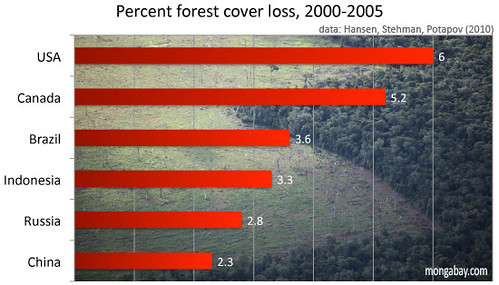
No wonder that President Lula and many Brazilian government officials get ticked off when they are lectured by gringos about saving the Amazon. A quick look at the graph above tells why.
I personally can report from nearly 30 years of concern for the ancient trees of the US Pacific Northwest that less than 10 percent of the primary forest is left and the old-growth giants are still being logged. The situation is as bad, some years even worse, north of the border in James Cameron's home country of Canada.
For comparison, although the sheer area of deforestation is greatest in Brazil, it is also true that 80 percent of the primary Amazon forest is still standing. That's an 80% Brazil vs 10% USA percent comparison!
Today the Brazilian problem may cover a larger area but so is the opportunity to do something about the future forest. Giant areas of non-fragmented forest and the greatest biodiversity in the world exist here. Conversely, in North America we have only remnants of primary forests. When a 500 year-old remnant cedar or fir falls in British Columbia or in Oregon it's among the last and pretty much over unless we can wait 500 years to get it back.
The Avatar movement is quite correct. The issue is global. It is not about pointing the finger of shame and blame at the developing world. Indeed, it must be stated again and again that the 20th Century development pattern devastated the environments of the so-called "advanced economies." If this pattern is to be changed for the 21st Century, those who first benefited from the destruction of nature, and continue to cause much of the problem, must change their consumption habits and help pay for a new way in the developing world.
Here is the deforestation story from mongabay.com:
United States has higher percentage of forest loss than Brazil
Jeremy Hance
mongabay.com
April 26, 2010
From 2000 to 2005 the world lost over a million square kilometers of forest.
Forests continue to decline worldwide, according to a new study in the Proceedings of the National Academy of Science (PNAS). Employing satellite imagery researchers found that over a million square kilometers of forest were lost around the world between 2000 and 2005. This represents a 3.1 percent loss of total forest as estimated from 2000. Yet the study reveals some surprises: including the fact that from 2000 to 2005 both the United States and Canada had higher percentages of forest loss than even Brazil.
Counting forest loss due either to human disturbance or natural causes, the study found that North America lost the most forest of the world's six forest-containing continents. Perhaps surprisingly, thirty percent of total forest loss occurred in North America alone. Combined with South America—the largest extent of tropical forests in the world—the two continents represent half of the world's total forest loss. Africa, in turn, suffered the least forest loss.
Forest loss by nation
Of the seven nations that contain over a million square kilometers of forest—Russia, Brazil, the United States, Canada, Indonesia, China, and the Democratic Republic of Congo—Brazil lost the most total forest during the five year time period.
According to the researchers Brazil lost 26,000 square kilometers (10,038 square miles) per year of its rainforest, and 7,000 square kilometers (2,702 square miles) in its dry tropical forests. Over the five years, total forest loss in Brazil came to 165,000 square kilometers (63,706 square miles). In all this represents 3.6 percent of its total 2000 forest cover: half a percent higher than the global average.
Canada was close behind Brazil: losing some 160,000 square kilometers (61,776 square miles) of its forest cover. However, proportionally Canada's forest loss equals 5.2 percent of the nation's total forest cover: higher than Brazil's percentage and over two points higher than the global average.
But the United States had the greatest percentage loss of the seven nations—even more than Brazil and Canada—losing 6 percent of its forest cover in just five years time, a total of 120,000 square kilometers (46,332 square miles). While fire and beetle infestation played a role in Alaska and the western US, large-scale logging in the southeast, along the western coast, and in the Midwest play a big role in the nation's continuing forest decline.
The researchers write that "the often publicized phenomenon of forest conversion within the humid tropics is observed in our results, but significant GFCL [i.e. global forest cover loss] is evident in all biomes. For example, rates of GFCL in regions such as the southeast United States are among the highest globally."
Article continues at mongabay.com with lots charts and graphics. Check it out.






No comments:
Post a Comment